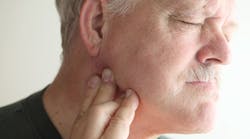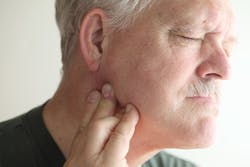Myofunctional therapy can enhance a patient's quality of life
By Timbrey Lind, RDH, and Shirley Gutkowski, RDH, BSDH
Some 2,500 years ago, Hippocrates noted that many people with severe headaches also had crooked teeth. There were no successful treatments until pharmaceuticals came along, which treated the symptoms, not the cause. A temporomandibular disorder (TMD) is a very common problem affecting up to 33% (I think more) of individuals. TMD is often viewed as a repetitive motion disorder and eventual breakdown of the masticatory structures (jaw joint and surrounding muscles). The current perspective is that it's an orofacial myofunctional disorder of mouth breathing.
Disorders of the temporomandibular joint are prevalent, most commonly observed in individuals between the ages of 20 and 40, although children as young as 14 are showing up with complaints. It is only in recent years that we have started to pay attention to the cause of TMD, and now we have many treatment options for helping our patients. So the questions to ask are:
- How do we know if it's a symptom or a cause?
- What is our role as oral health professionals?
- How does orofacial myofunctional therapy fit in?
We are so used to hearing that clenching and grinding are common symptoms or causes of TMD. Recent studies have come out to prove that clenching and grinding are attributed to airway resistance. Airway resistance is a condition where the airway is too narrow or blocked by mucus from allergies or by interference from the tongue. The body's response to the lack of air overnight is to keep the sleeper aroused by grinding the teeth. Bruxing in people of all ages can be linked to airway disturbances during sleep.
Neck and back pain, commonly attributed to TMD or clenching or bruxing, has been relieved by releasing untreated tongue-tie. The tied tongue can be a cause of sleep-disordered breathing, leading to bruxing, as well as leading to pain in the neck or upper back.
What's not normal
By finding the cause, the treatment can be more successful.
Consequences of TMD include clicking/popping or grating sounds in the jaw, limited opening, flat teeth, pain in the jaw joint, and headaches. Almost every TMD patient I see suffers from headaches and/or migraines. It's interesting how many people do not mention this as a concern unless they are asked, because it has become their norm. Daily headaches are not normal. We need to remind them of that.
Even more importantly, mouth breathing is not normal and is a huge cause of TMD. To paint the picture a little better for you, this is how it comes about. When a patient cannot breathe through their nose due to allergies, enlarged tonsils, or some other reason, they begin to breathe through their mouth. When they breathe through their mouth, the tongue rests incorrectly on the floor instead of its insertion point on the roof of the mouth. If the tongue is not resting on the anterior palate, it is not providing the support the maxilla needs to form the correct U-shape arch.
Instead, the maxilla collapses into a V-shaped arch, throwing the entire orofacial system off balance. The narrowing of the upper arch naturally results in pushing the lower jaw back, which dislocates the TMJ disk, causing TMD. Here is a link to a great YouTube video about TMD: youtu.be/HZHrK6Ua5d4.
Feeling good naturally
Another common factor to consider for patients who present with TMD is stress. When I ask patients about clenching or grinding, they all automatically relate it to stress. Although I do not agree that stress is a cause of TMD, there is something to be said about the effects it has on our bodies. When we are feeling stressed, we naturally tend to direct tension to our jaws.
What science has shown is that the redirected tension actually releases the "feel good" hormone, also known as oxytocin. This hormone plays another major role, reducing cortisol levels ("fight or flight" hormone) and reducing inflammation in the vagus nerve. The vagus nerve runs from the brain down to the stomach and touches (almost) every major organ along the way. The point is not to encourage clenching in order to release oxytocin. There are other ways to release oxytocin that are beneficial, e.g., giving away money or hugging someone. I like the sound of those much better than clenching! I just wanted to point out how important the role of oxytocin release is, and why clenching becomes such a habit.
When compensation such as clenching occurs, the body reverts to that reaction automatically, without even recognizing it. Over time, the muscles reach compensation burnout and have to be treated. In dentistry, we've been thinking we're treating the cause by applying splints and gadgets, but without actually treating why it's happening. What we do in orofacial myofunctional therapy is focus strictly on the why and break that negative cycle. Compensation is one way a person ends up getting TMD, but it also connects us to another cause: trauma. This can be physical trauma or even emotional trauma. Someone who has experienced emotional trauma may hold those feelings in their jaw in an effort to release oxytocin. Physical trauma, such as a car accident, being thrown from a horse, or any blow to the face, can result in clenching for oxytocin release. If we break an arm, physical therapy is usually recommended to regain the proper range of motion. But what about for the face and jaw? That is where orofacial myofunctional therapy comes into consideration.
Another possible cause of TMD is extraction of bicuspid teeth for orthodontics. We used to think that if we remove teeth to make room for crowded teeth, it was for the patient's benefit. But what if, when we do that, we are not only taking out perfectly healthy teeth, we are also altering the entire structure of the oronasal airway? The space is decreased, obviously. We are creating a smaller space for the tongue to rest. Let's remember that the maxilla is also the floor of the sinuses. If that's smaller, there's a good chance the airway is compromised, forcing the body to find a way to compensate. If the change doesn't occur right away, any cold or allergy attack can make the body compensate by forcing the mouth open to get air; then a mouth-breathing habit develops. Also, when the muscles are strained, they are putting inappropriate force on the jaw joint, which results in pain. Voilà! A domino effect. And maybe that initiates headaches that turn into migraines and ripples into head, neck, and back pain.
Getting out of pain
The good news is, as oral health professionals, we can play a huge role in preventing TMD and getting our patients out of pain. The first thing we need to do is notice it. This means looking for all the signs and symptoms TMD expresses.
Mouth breathing is an easy one to notice because the patient will more than likely be doing it when they walk through the door. Chapped lips and anterior gingivitis are other obvious symptoms of mouth breathing. We could even do simple palpations on certain muscles such as the masseter, pterygoid, and temporalis to see how they react. Have the patient give feedback, for example, on a scale of 1-5 of the level of soreness in the muscle, and record it. The next thing we could do is refer to a trained orofacial myofunctional therapist to provide the patient with a noninvasive, comfortable treatment that works.
A study done by a TMD expert and OMT leader in São Paulo, Brazil, Claudia Maria de Felicio, called "The Effects of Orofacial Myofunctional Therapy on Temporomandibular Disorders" reported, "OMT had... a significant reduction of pain sensitivity to palpations for all muscles studied... increased measures of mandibular range of motion... reduced frequency and severity of signs and symptoms..."
With orofacial myofunctional therapy, a main goal is to establish nasal breathing and correct oral posture by toning and repatterning the head and neck muscles. By "repatterning," I literally mean re-creating strong pathways between the brain and these muscles. This is what makes it so successful.
We do this by identifying compensations. When we focus on establishing nasal breathing and correcting oral posture, this insinuates a lip seal and tongue to the palate at ALL times, unless they are in use. An article written on lack of lip seal (Harari et al., 2010) and how it leads to occlusal dysfunction goes right along with the video I recommended. Training children to keep their lips together and tongue to the palate encourages balanced muscles and forward growth in their faces. Harmonious muscle pattern is important to correct a muscle-related TMD. Myofunctional therapists are trained to identify compensations such as mouth breathing and eliminate habits that develop because of the compensations. This allows the muscles to habituate into a physiological normal way. Doing the least invasive treatment first is always best.
Myofunctional therapy may enhance a person's quality of life, especially if they are in pain from their jaw joint constantly working in dysfunction. Consider this when you talk to your patient and ask them how their jaw joint is feeling. A good way to find a myofunctional therapist near you is to google it for your area, or look on AOMTinfo.org and click on "Find a therapist." Other resources are on CrossLinkRadio.com. Listen to interviews about the ways that OMT can benefit your patients. RDH
Timbrey Lind, RDH, OMT, is a practicing dental hygienist with a holistic approach to care. Specializing in orofacial myofunctional therapy, her passions are working with infants and children. Her practice, The Connection, is based in Agoura Hills, California. Shirley Gutkowski, RDH, BSDH, is a practicing dental hygienist specializing in orofacial myofunctional therapy. Her practice, Primal Air, LLC, is in Sun Prairie, Wisconsin. Ms. Gutkowski is also the host of Cross Link Radio, a podcast with timely information integrating oral and systemic health.







